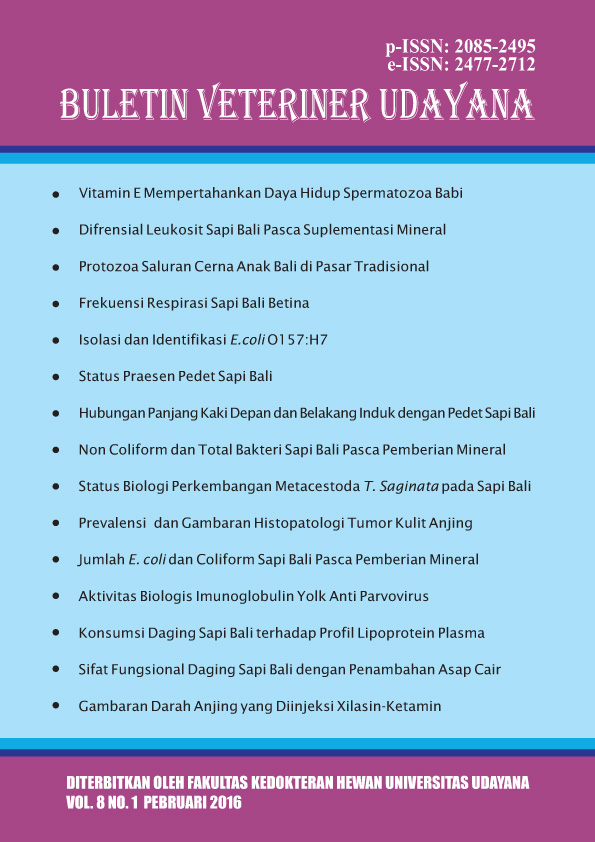THE RELATION OF LONG PARTS OF FRONT AND REAR LEGS ON BALI CATLE WITH HER NEWBORN CALVES
Abstract
This study aims were to determine the relationship between the parts of the front and rear foot length of bali calf with its parent. The object of the research consisted of 30 breeding calves and 30 individuals namely 15 male and female newborn respectively. Data in the form of measures footlong pieces of stem and parts of the calf leg length were analyzed using linear regression analysis. To determine whether there are differences between the parts of the front and rear foot length between the male with the female calf in a test with test T. The greater the ratio shows the development of long pieces of front and rear legs shows the earlier development. At birth the sizeof the back foot bottom, middle and top of the calf males and females, 63.7%, 46.5%, and 43.5% respectively of the size of its parent. Similarly, the size of the front foot down the middle and upperparts, 59.2%, 46.7%, and 44.9% respectively of the size of its parent. Development of parts of the front and rear leg starting from the bottom, middle and last at the top.
Downloads
References
Davies HL. 1982. Principle on growth of animal. In H. L. Davies, Nutrition on Growth Manual. AUIDP.
Eka Y. 2013 Pertumbuhan dimensi lebar tubuh pedet sapi bali. Indonesia Med Vet, 2(3): 230-236.
Hardjosubroto W dan Astuti JM. 1993. Buku pintar peternakan. PT Gramedia Widiasarana Press, Jakarta.
Kadarsih S. 2003. Peranan ukuran tubuh terhadap bobot badan sapi bali di provinsi bengkulu. J Penelitian UNIB, 9(1): 45-48.
Sampurna IP, Saka IK, Oka IGL and Sentana P. 2013. Biplot simulation of exponential function to determine body dimension’s growth rate of bali calf. Canadian J Comp in Math Nat Sci Eng Med, 4(1): 87-92.
Sampurna IP, Saka IK, Oka IGL and Sentana P. 2014. Patterns of growth of bali cattle dimensions. ARPN J of Sci and Tech, 5(1): 20-30.
Soares FS and Dryden GM. 2011. A body condition scoring system for bali cattle. Asian-Aust J Anim Sci, 24(11): 1587-1594.
Tazkia R. 2008. Pola dan pendugaan sifat pertumbuhan sapi friesian-holstein betina berdasarkan ukuran tubuh di kpsbu lembang. Fakultas Peternakan, Institut Pertanian Bogor.
Tillman AD, Hartadi H, Reksohadiprodjo S, Prawirokusumo S dan Lebdosoekojo S.1984. Ilmu makanan ternak dasar. 2 Ed. Gadjah Mada University-Press, Yogyakarta
Tim Pusat Kajian Sapi Bali. 2012. Sapi bali sumberdaya genetik asli Indonesia. Udayana University Press, Denpasar.
Utomo B, Prawirodigdo S, Sarjana dan Sutjadmogo. 2006. Perfomans pedet sapi perah dengan perlakuan induk saat masa akhir kebuntingan. Seminar Nasional Teknologi Peternakan dan Veteriner.
Warwick EJ, Astuti JM. dan Kardjosubroto W. 1983. Pemuliaan ternak. Gajah Mada University Press, Yogyakarta.





